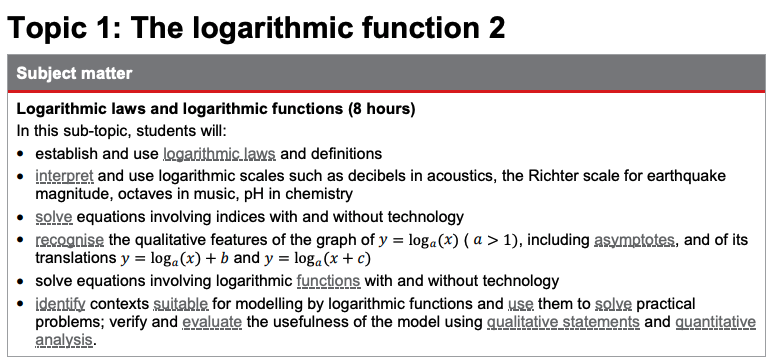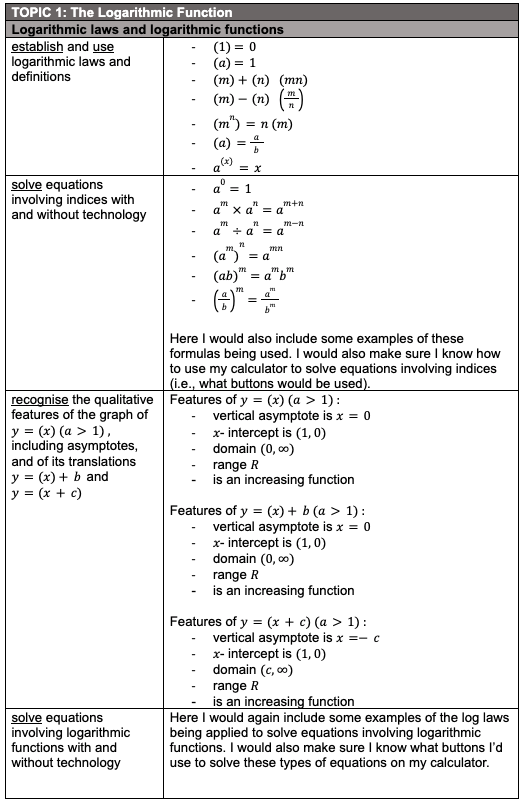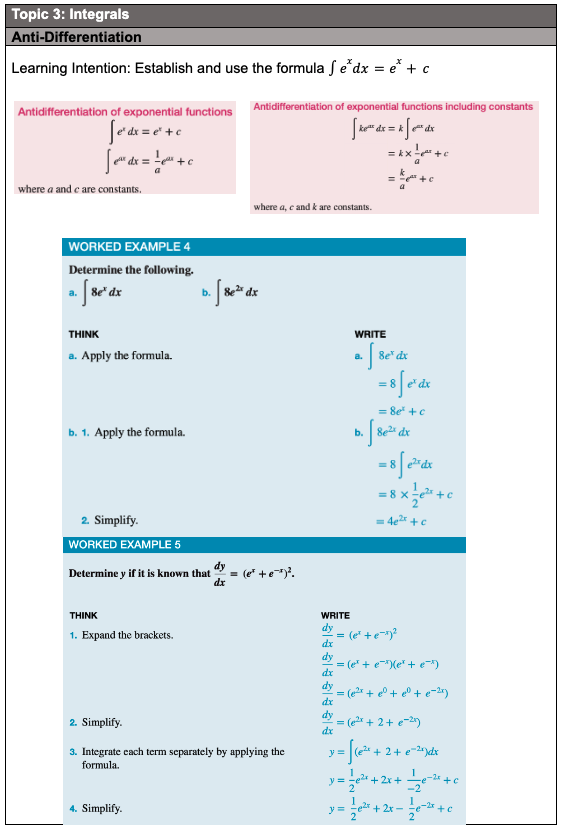Figuring out the most effective way to take QCAA Maths notes can be pretty tricky. Different people have different techniques, but what everyone can agree on is how important good quality notes are!
The quality of your notes (and knowing what level of QCAA maths is the right fit for you) can really make or break your success with study, revision, and ultimately, your exam results.
So, keep reading to find out how to take great notes for any QLD Maths subject!
Tip 1: Use the syllabus as a Guide
Tip 2: Understand the Cognitive Verbs
Tip 3: Discover which note taking styles suits you best
Tip 4: Review your notes regularly and make connections
Tip 1: Use the syllabus as a Guide
Every concept you learn in Maths will be derived from the QCAA syllabus, making it the most comprehensive checklist.
In the syllabus, topics (3-6 per Unit) are split into several subtopics, and further split into dot points. These dot points are your guide to what concepts, methods, and formulas you need to learn.
Each subtopic will also have an indication of how many hours of class time should be spent on it, which you can use as an indication of how much time and effort you should put into each topic.
Something that can be quite helpful is to create revision tables using the syllabus dot points, like the one in the example below.
The second row consists of a subtopic from the syllabus (e.g., logarithmic laws and logarithmic functions). The first column consists of the subject matter dot points under that particular topic (number of dot points will vary — this can be a good indication of how important a topic is!).
The third column consists of the actual content that is covered by the associated subject matter dot point. You can make this section much more detailed than I have, by including pictures, diagrams, tables, links to websites or videos and other tips/tricks.
Finally, it’s not evident here, but I would also include a fourth column consisting of example questions relating to each subject matter dot point.
Create the actual table during the holidays before you start each unit. Once you start the unit, fill out each section as you cover it in class. This can also be an excellent way to identify any gaps in your knowledge and a great revision tool!
Looking for a Maths tutor in the Gold Coast? Check out more info on our holistic tutoring here!
Tip 2: Understand the Cognitive Verbs
Gain a good understanding of what each cognitive verb means. In Maths, the common cognitive verbs include:
- Define
- Recognise
- Establish
- Solve
- Identify
- Calculate
- Use
- Estimate
These verbs are a great indication of what depth you need to understand and/or apply a concept, method, or formula as well as what type of questions would be involved.
For a full list of the QCAA Cognitive Verbs and their definitions, check out our guide here!
Tip 3: Discover which note taking styles suits you best
Explore different styles of note taking during Year 11 and find out what works best for you. Once you have a solid system (hopefully by the time Unit 3 starts), use it and stick to it!
This makes it easier to revise as you know exactly how your notes are organised and where to look for things. For example, your worked examples might be done in coloured pens, or your headings might be highlighted.
In your notes, it is important to include what topic, subtopic and dot-point on the syllabus is being covered for easy reference. Integrating examples into your note taking is also essential in maths, specifically annotated examples or worked examples that you can refer back to when practising.
The main thing that separates Maths from other QCAA subjects is how example-based it is. You’ll find that you have many more numbers and examples as opposed to words and explanations.
Something I found super helpful was having my notes and worked examples in one book, whilst having practice questions in a separate book. This makes it a lot easier to find notes when you’re looking for them. If anything interesting or important came up when doing practice questions, I would add it to the notes book.
Images sourced from Jacaranda Maths Quest Mathematical Methods 12 Units 3 & 4
Tip 4: Review your QCAA Maths notes regularly and make connections
Maths is all about building on your knowledge of particular concepts in order to apply them in more varied and complex ways.
These concepts often link to each other. This means that there’s a decent chance that you may understand something about a particular topic whilst learning about a different one.
In this case, going back to your notes and editing or adding to them can be a great idea. As you make more connections, your notes can be built on simultaneously.
A great way to make connections is to review each concept within 1 hour of learning it, again within 24 hours of learning it, and then again within 1 week of learning it.
This method drastically improves active recall abilities and means you don’t have to re-learn everything three weeks before the exam.
If you’re aiming to achieve in an A in your Maths subject, check out our guides:
On the hunt for other QCAA Maths resources?
Check out some of our other articles and guides below:
- The Ultimate Content Guide for Term 3 of the QCE
- How to Ace Your External Assessment for QCAA Maths Methods
- How to Ace Your External Assessment for General Maths
- Should You Drop Down from Maths Methods to General Maths for the QCAA?
- How to Structure Your PSMT Report for QCAA Mathematical Methods
- The Ultimate Guide to Writing a Problem-Solving and Modelling Task (PSMT) Report for General Maths
- How to Answer Complex Unfamiliar Questions in QCAA Maths
Are you looking for some extra help with the studying QCAA Maths and your study notes?
We have an incredible team of QLD Maths tutors and mentors!
We can help you master the Maths syllabus and ace your upcoming Maths assessments with personalised lessons conducted one-on-one in your home or online!
We support the Gold Coast for Maths tutoring too!
We’ve supported over 8,000 students over the last 11 years, and on average our students score mark improvements of over 20%!
To find out more and get started with an inspirational QLD tutor and mentor, get in touch today or give us a ring on 1300 267 888!
Yalindi Binduhewa is an Art of Smart tutor based in Queensland and was part of the very first cohort to go through the ATAR system, so she knows exactly how fun and enjoyable it can be. She is currently studying a Bachelor of Medical Imaging (Honours) at QUT and is loving it. When she’s not doing uni-related stuff or tutoring, she’s hanging out with her friends, rewatching a show for the 100th time, or trying out new crafty projects and discovering that she doesn’t have a talent for everything.






